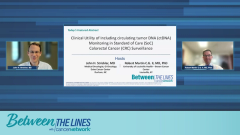
ctDNA Monitoring as SOC Surveillance Following CRC Resection: Financial Considerations
Experts discuss that although financial concerns about ctDNA testing exist, they are generally manageable with patient education and transparent communication, and that incorporating ctDNA into formal clinical guidelines could reduce insurance barriers and alleviate patient anxiety, ultimately enabling broader access to this valuable personalized cancer monitoring tool.
Episodes in this series

The question of financial impact often arises when discussing the broader adoption of circulating tumor DNA (ctDNA) testing in clinical practice. While Although cost concerns exist, they are generally not a significantmajor factor in day-to-day care, especially when there is clear patient education. Patients today are more empowered and informed than ever before, actively seeking access to their health data and transparency in their treatment plans. This shift toward patient engagement helps reduce anxiety related to testing costs, as patients understand the value and purpose behind the ctDNA monitoring. Offering immediate access to results through electronic medical records further supports this transparency and trust.
Incorporating ctDNA testing into formal clinical guidelines could significantly reduce some of the current barriers, such as insurance denials and confusing billing communications. These denial letters can sometimes cause unnecessary stress for patients who might not fully understand the nuances of insurance coverage. However, with ongoing education and clear communication from the healthcareealth care team, these concerns are typically resolved quickly. Many patients are reassured simply by being reminded that their test is covered or that they do not owe additional fees. In many cases, support staff like such as medical assistants play a vital role in managing these conversations, helping to defuse patient worries without burdening the physician.
Overall, the integration of ctDNA testing into standard guidelines would likely ease financial concerns for both patients and providers. As awareness grows and education improves, financial worries diminish, allowing more patients to benefit from this precise and personalized cancer monitoring tool. The financial impact is therefore manageable and outweighed by the clinical benefits, especially when accompanied by proactive communication and patient empowerment.
Newsletter
Stay up to date on recent advances in the multidisciplinary approach to cancer.














































































